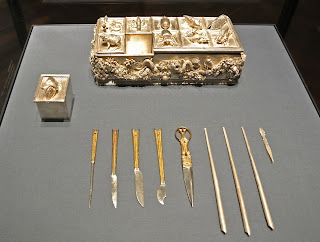The most basic, and vital, thing to understand about shamanism is that it is a performance art. What is performed? Integrative Magic. For the shaman is an artist and a healer. The shaman is a medium (in the best sense of the word), a conduit and channel for the alchemical harmonization of symbolic, ecological, and cosmic energies. Elected by the spirits, supernatural beings that participate in but are not of or bound to this earthly realm, the shaman is an individual psychically sensitive and attuned to the symbolic economy that infuses and integrates the fabric of the culture, ecology, and cosmos in which the shaman is situated. Through the artful employment of certain “techniques of ecstasy” (Eliade), such as trance (achieved through various performative means), the shaman is able to engage in a kind of “soul flight” to reach knowledge, information, and wisdom otherwise inaccessible to ordinary people. And the shaman uses this insight for healing purposes—to diagnose and treat particularly ailments of the spirit and psyche—whether those ailments pertain to an individual or an entire culture. For, again, at the center of the shaman’s art is the holistic integration of the fragmented and diseased elements (symbolic, social, psychological) that, more properly fused and balanced, constitute health and harmony.
Shamanism is an ancient healing, performative, and “magico-religious” practice of Palaeolithic origin (ca. 40,000 years old or older). It has survived thousands, indeed tens of thousands, of years of cultural transformation, persecution, scientific skepticism, and modern and postmodern charlatanism of many kinds (including the sort cited only a few days ago in the case of the ridiculous, yet clearly dangerous, ‘QAnon Shaman’). Because it is also a pre-literate and performative-based tradition, shamanism has also endured despite distortions and damages wrought by the book-based, monotheistic religious structures that gained dominance and have effectively defined the parameters of accepted religious and spiritual practice for the past 2,000+ years on this planet. And yet, through the tundras and the tropics, across the Great Plains and Grand Canyons, shamanism, magic, survives.
What role will shamanism play in the 21st century, and beyond? Provided good sense and respect for the sacred in the great and diverse cultural traditions of the world prevail—and especially in the men and women elected to protect and preserve these ancient mysteries—I have some optimism, and faith, that the shamanic spirit will yet prove a great asset to cultural healing, ecological restoration, and integrative restructuring of the fragmented psyche that has lately so sadly come to define so much of the daily experience of most humans on this Earth.
The shamanic spirit, or ethos, incidentally, need not be thought as limited to Altai mountain wizards or Amazonian medicine men (however anthropologically defined), or powwow priests of any indigenous persuasion. The Catholic priest can be, and has been, a shaman; so too can the Hindu sage or yogi, the Baptist minister, the Neopagan Druid, the academic philosopher, the humble Facebook poet. The point is to keep the practice sacred, to remember—and embody—those sacred teachings and rituals, the myths and magic and stories—in short, the symbolic economies—that have guided and structured and given meaning to the shared human experience since the dawn of time.
Shamanism is not a game; it is not a parlor trick or circus sideshow or a face to paint on for Halloween (or storming the U.S. Capitol, as the case might be). And certainly it is not a guise or gimmick to mobilize for the purposes of riot or insurrection or the desecration of democracy, in America or anywhere. Shamanism is, indeed, a religion. It is by any reasonable account the world’s oldest spiritual practice, and the bedrock and genesis for all religion, pagan or Christian or otherwise, if by “religion” we mean a culturally organized and symbolically centered celebration of the sacred. It is to be taken seriously and accorded the respect and care that the sacred deserves. If, as the Hebrew proverb has it, “death and life are in the power of the tongue,” all the more so is the potential for harm or healing in the hands of the shaman—a figure, moreover, who is always sanctioned by his or her society and never “self-proclaimed.” An egotistic shaman is a man on his way out—always—whatever power, or presumed power, he or she may be thought to hold. The shaman is an individual, but like all individuals a profoundly socially dependent creature. May any shaman, therefore, be wise and humble enough to use the gift and power wisely, and for the betterment of the human condition, and the environment that sustains and ultimately makes that condition possible.
So many people are hurting, so many divisions and points of discord exist, so many fractures and wounds in need of reconciliation. Shamanism holds great power to effect the kinds of cures needed to restore a proper balance. For this is what true medicine, and magic, does and always has done.
The shaman, in short, is a healer, but he or she is also an artist, a poet, a musician of the soul and a tuner of out of tune instruments, which all humans are in one respect or another. There is hardly a calling higher or more sacred or more vitally needed than that of the shaman. All illness, Novalis said, is a musical illness in need of a musical solution. May the shaman minister first and last and always to that most intimate and vital place where we find, and live, our deepest humanity: I mean to say, in Art.
Shaman holding a séance by fire. Settlement Kyzyl region Tuva, Russia. (Photo: Wikipedia.)










